1. Introduction
Untitled Document
 Ordinary
stereo headphones usually produce the discomforting effect of sound coming
from the middle of the listener's head. In addition, if one connects
these headphones directly on a soundcard's output, he/she will probably get
disappointed by the limited loudness at maximum
volume level. That is why a new breed of headphones started to appear in the
market: Headphones for computer use! These come in many flavors some of them
featuring 5.1 channels audio, build in microphone and amplifier control box
or USB audio controllers.
Teac has been a player in the computer speakers/headphones area quite some time
now. Today we will review three of their headphones.
Ordinary
stereo headphones usually produce the discomforting effect of sound coming
from the middle of the listener's head. In addition, if one connects
these headphones directly on a soundcard's output, he/she will probably get
disappointed by the limited loudness at maximum
volume level. That is why a new breed of headphones started to appear in the
market: Headphones for computer use! These come in many flavors some of them
featuring 5.1 channels audio, build in microphone and amplifier control box
or USB audio controllers.
Teac has been a player in the computer speakers/headphones area quite some time
now. Today we will review three of their headphones.
- TEAC HP-6D
- TEAC HP-7D
- TEAC HP-11
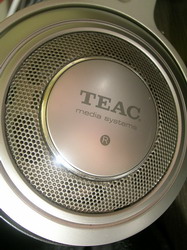
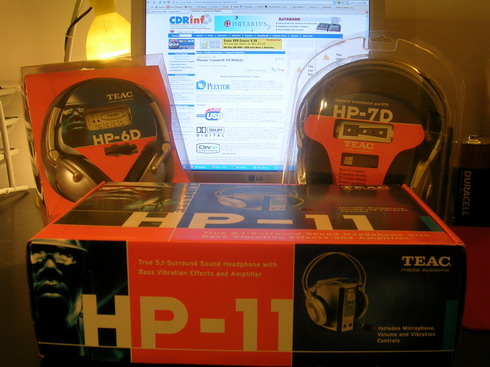
2. TEAC HP-6D
The cheapest of the three, build on the C-Media CM108 USB Audio I/O controller,
offers a virtual 5.1 surround This means that it does not literally have 6
channels, neither 6 speakers build in the headphones. However it does not have
the effect of sound coming from the middle of your head either, thanks to a "virtual" surround
ability. Of course the virtual surround is not anywhere near a real surround
5.1 home theatre / hi-fi but it does sound more
interesting
than the typical stereo setup. On the other hand, if you are not too keen on
these fancy virtual stuff, then you can easily switch it to simple stereo mode,
from the chipset's driver.
Headphones connect to the computer via USB, hence do not interfere with any existing soundcard, cables etc. They appear under windows as an additional sound device, and applications (such as winamp, dvd players, etc) can be configured to use the headphones instead of the default playback/recording device. In addition, having a build in amplifier means that there is more than enough loudness available. The arm holding each speaker folds in two, allowing them to folding nicely in a compact shape.
I liked the fact that the headphones worked just fine upon first plug on windows XP SP2, without installing any drivers. Of course I later installed the drivers, in order to take full advantage of the features offered by the chipset.


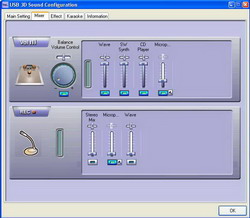
The provided driver, on the 8cm CDROM does support karaoke - echo effect,
on the mic input, as well as "pich" and "voice removal" but
does not have the "monster, cartoon" effects of "magic software" (see
HP-7D ) even though it mentions "magic voice software included" on
the box. I tried to find a newer driver on the web that might include these
cool monster/cartoon voice effects but had no luck.
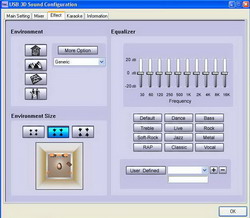
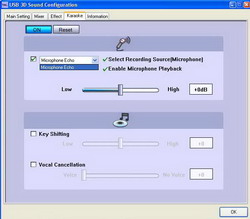
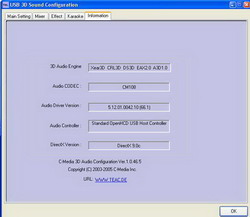
The equalizer, unlike most cost efficient sound devices, can have a positive effect on the resulted sound (i.e. enhancing bass) without major distortion, and cropping that usually digital equalizers have. The microphone is build on the cable, and performs ok like most computer mics. +20dB boost is supported by the driver, hence voice capture is possible without having to swallow the mic, however you need to be careful when moving about cause pops and scratches will end quite loud.
The red power led is flashing when the USB is in use since it is not a good thing to unplug USB devices when USB communication takes place. The headphones look quite nice, feel very comfortable on the ears and offer a good environment noise isolation.
| USB DAC/Amplifier specifications |
Chipset: |
C-Media CM108 |
Signal/noise ratio: |
>- 80dB |
Selection: |
>-60dB |
Distortion: |
< 0.5% |
Frequency range: |
20-20kHz |
| |
| Headphone specifications |
Speakers diameter: |
40 mm |
Impedance: |
64 Ohms |
Frequency range: |
20-20kHz |
| |
| Microphone specifications |
Type: |
Electret capuse 7mm Omnidirectional |
Impedance: |
2200 Ohms +/- 15% |
Sensitivity: |
60dB +/- 2 dB |
Frequency range: |
30 – 16kHz |
Sound: There is not much to say about the sound quality of these headphones. One should consider that they cost only about 20$ and include USB audio controller and mic, therefore do not expect anything impressive on the “speakers” side . However the speakers are not that bad and they do sound better than many similar priced. passive (without USB controller & amplifier) headphones available.
Overall grade: A-
Pros: Comfortable shape, decent sound for it’s price, mic, USB audio controller
Cons: Distortion at higher volume levels, no magic sound monster/cartoon effects
3. TEAC HP-7D
These headphones have all the advantages of HP-6D, being also USB Audio controller based, with the major difference that they offer a real 6 channel sound, with 6 speakers build in. As a result, these speakers definately do not feel like the sound is comming from one's head. In addition, the sound quality of these headphones is quite impressive. Dividing the energy in to six speakers means that less stress is put on each individual speaker, hence the result is crisper, clearer sound with a very deep bass. Especially the bass speaker seems that is not sweating at all, and can be further pushed by utilizing the equalizer of the driver, without major cropping and distortion. Medium and high frequencies are quite accurate as well, allowing details to be heard.
Build wise, the headphones are slightly too tight (or my head is too big)
and the fluffy velvet surface of the "ear pillows" is not the best
material for hot climates cause it gives a warm feeling at the ears. Other
than that
they are comfortable. On top of the driver features/settings that HP-6D have,
this driver offers the "monster / cartoon" effect which alters
the way your voice sounds in real time making it a wicked suprice for online
games that support voice.
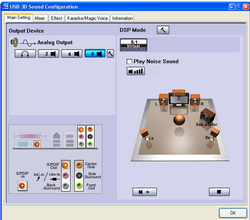
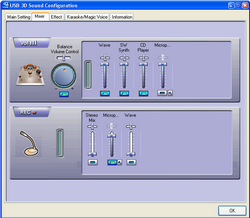
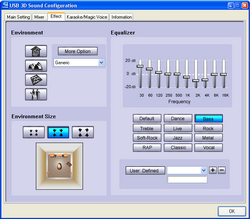


Microphone comes on a separate flexible rod, that optionally connects to the headphones via a small jack. This allows better placement of microphone when used. In addition good size foam is used for protecting the mic from air blows. As a result the mic has a very good reception, allowing the sensitivity not to be set to maximum, resulting in very good recording quality.
| USB DAC/Amplifier 5.1 specifications |
Chipset: |
C-Media CM106 (USB 2.0) |
Signal/noise ratio: |
>- 80dB |
Selection: |
>-60dB |
Distortion: |
< 0.5% |
Frequency range front,rear,center: |
20-20kHz |
Frequency range subwoofer: |
20-120Hz |
| |
| Headphone specifications |
Power: |
500mW |
Front speakers diameter: |
40 mm |
Front impedance: |
64 Ohms |
Front Frequency range: |
20-20kHz |
Rear/Center speakers diameter: |
30 mm |
Rear/Center impedance: |
32 Ohms |
Rear/Center frequency range: |
20-20kHz |
Sub speaker diameter: |
30 mm |
Sub impedance: |
8 Ohms |
Sub frequency range: |
20-120 Hz |
| |
| Microphone specifications |
Type: |
Electret capuse 9,7mm Omnidirectional |
Impedance: |
2200 Ohms +/- 15% |
Sensitivity: |
60dB +/- 2 dB |
Frequency range: |
30 - 16kHz |

Overall grade: A+
Pros: Very good sound for it’s price (about 40$), deep bass, mic, USB audio controller, magic voice effects
Cons: Nothing serious
4. TEAC HP-11
HP-11 seems to use the same speakers setup as the HP-7D, connected however on totally different hardware. These headphones are analog, with an separate 5.1 analog amplifier box. One would expect entirely different sound results from the HP-7D however, surprisingly enough they sound almost the same.
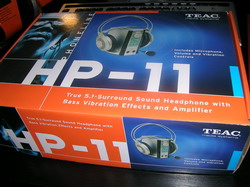
An explanation for this, is that both the analog amplifier and the USB audio controller, supersede the sound quality that the actual speakers can produce, hence the end result is limited by the speakers themselves. Since both headphones use the same speakers, the end result is the same.

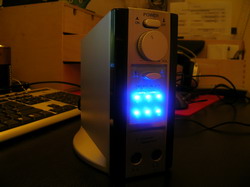
Connection wise, these headphones come with a wide selection of cables and converters allowing them to connect to a 5.1 or stereo analog computer output, or a 5.1 or stereo analog DVD/TV output.
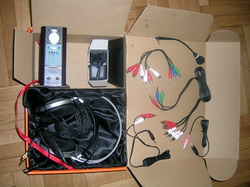
Not using a USB connection means that these headphones can connect directly to the analog 5,1 or stereo outputs of a DVD player, without needing a computer. Cables partial colouring, was a bit disappointing though, since you need to mark them your self

In addition, an in line controller is offered, for controlling the volume of front/rear/center/sub speakers separately.
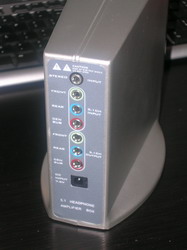
The amplifier box, other than the 3 inputs, also has 3 outputs, allowing existing connections/cabling to coexist with the headphone amplifier box. In adition a stereo input is also available, and gets enabled with the 5.1 / Stereo switch at the front of the box.
| Amplifier 5.1 specifications |
Audio inputs : |
Aux (Stereo)
DVD (5.1)
|
Audio outputs : |
5.1 channel |
Signal/noise ratio: |
>- 80dB |
Selection: |
>-60dB |
Distortion: |
< 0.5% |
Frequency range front,rear,center: |
20-20kHz |
Frequency range subwoofer: |
20-120Hz |
| |
| Headphone specifications |
Power: |
500mW |
Front speakers diameter: |
40 mm |
Front impedance: |
64 Ohms |
Front Frequency range: |
20-20kHz |
Rear/Center speakers diameter: |
30 mm |
Rear/Center impedance: |
32 Ohms |
Rear/Center frequency range: |
20-20kHz |
Sub speaker diameter: |
30 mm |
Sub impedance: |
8 Ohms |
Sub frequency range: |
20-120 Hz |
| |
| Microphone specifications |
Type: |
Electret capuse 9,7mm Omnidirectional |
Impedance: |
2200 Ohms +/- 15% |
Sensitivity: |
60dB +/- 2 dB |
Frequency range: |
30 - 16kHz |
Overall grade: A+
Pros: Very good sound for it’s price (about 40$) deep bass, mic, can be used with various analog devices
Cons: Nothing serious